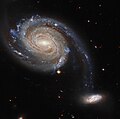Datei:NGC7752, NGC7753 - HST - Potw2142a.jpg
Zur Navigation springen
Zur Suche springen

Größe dieser Vorschau: 604 × 600 Pixel. Weitere Auflösungen: 242 × 240 Pixel | 483 × 480 Pixel | 774 × 768 Pixel | 1.031 × 1.024 Pixel | 2.063 × 2.048 Pixel | 3.908 × 3.880 Pixel
Originaldatei (3.908 × 3.880 Pixel, Dateigröße: 3,2 MB, MIME-Typ: image/jpeg)
Dateiversionen
Klicke auf einen Zeitpunkt, um diese Version zu laden.
| Version vom | Vorschaubild | Maße | Benutzer | Kommentar | |
|---|---|---|---|---|---|
| aktuell | 07:11, 18. Okt. 2021 |  | 3.908 × 3.880 (3,2 MB) | Fabian RRRR | == {{int:filedesc}} == {{Information |description={{en|1='''Invisible Galactic Gale NGC 4666 takes centre stage in this image from the NASA/ESA Hubble Space Telescope. This majestic spiral galaxy lies about 80 million light-years away in the constellation Virgo, and is undergoing a particularly intense episode of star formation. Astronomers refer to galaxies which are forming stars anomalously quickly as starburst galaxies. NGC 4666’s starburst is thought to be due to gravitational interact... |
Dateiverwendung
Die folgenden 3 Seiten verwenden diese Datei:
Globale Dateiverwendung
Die nachfolgenden anderen Wikis verwenden diese Datei:
- Verwendung auf ar.wikipedia.org
- Verwendung auf az.wikipedia.org
- Verwendung auf be.wikipedia.org
- Verwendung auf ce.wikipedia.org
- Verwendung auf diq.wikipedia.org
- Verwendung auf en.wikipedia.org
- Verwendung auf eu.wikipedia.org
- Verwendung auf fa.wikipedia.org
- Verwendung auf fr.wikipedia.org
- Verwendung auf mg.wikipedia.org
- Verwendung auf mk.wikipedia.org
- Verwendung auf ru.wikipedia.org
- Verwendung auf sk.wikipedia.org
- Verwendung auf tt.wikipedia.org
- Verwendung auf www.wikidata.org